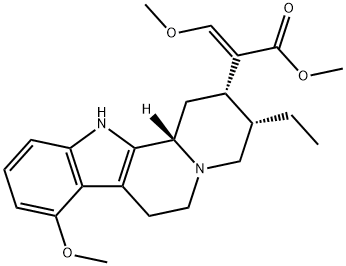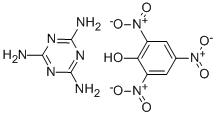AMMONIUM 2,4,6-TRINITROPHENOLATE
- CAS NO.:131-74-8
- Empirical Formula: C6H6N4O7
- Molecular Weight: 246.13
- MDL number: MFCD00661079
- EINECS: 205-038-3
- SAFETY DATA SHEET (SDS)
- Update Date: 2024-12-18 14:15:30

What is AMMONIUM 2,4,6-TRINITROPHENOLATE?
Description
Ammonium picrate is a nitro hydrocarbon derivative. It is composed of yellow crystals with not less than 10% water by mass. Ammonium picrate is highly explosive when dry and a flammable solid when wet, and is slightly soluble in water. The four-digit UN identification number for ammonium picrate with not less than 10% water is 1310. The primary uses are in pyrotechnics and explosives.
Chemical properties
Ammonium picrate is a bright yellow crystalline solid, which turns red if contaminated.
The Uses of AMMONIUM 2,4,6-TRINITROPHENOLATE
In explosives, fireworks, rocket propellants.
General Description
A yellow crystalline solid. Produces toxic oxides of nitrogen during decomposition . Easily ignited and burns vigorously. May explode under prolonged exposure to fire or heat. The primary hazard is the blast effect of instantaneous explosion and not from flying projectiles and fragments.
Reactivity Profile
AMMONIUM PICRATE is a high explosive when dry [Hawley]. Mixing with water greatly reduces its sensitivity to shock, friction and heat. Traces of metallic picrates may significantly lower the temperature at which this mixture will explode (Military Explosives p. 96). Self-reactive.
Hazard
A high explosive when dry, flammable when wet.
Health Hazard
Fire may produce irritating, corrosive and/or toxic gases.
Fire Hazard
MAY EXPLODE AND THROW FRAGMENTS 1600 meters (1 MILE) OR MORE IF FIRE REACHES CARGO.
Safety Profile
An allergen. Moderately irritating to skin, eyes, and mucous membranes. Moderately flammable by spontaneous chemical reaction. A powerful oxidizer that reacts vigorously with reducing materials. Dangerous explosive when shocked or heated. The presence of trace metals increases its heat sensitivity. See PICRIC ACID, NITRATES, and EXPLOSIVES, HIGH. When heated to decomposition it emits highly toxic fumes of NOx.
Potential Exposure
Used in explosives, fireworks and rocket propellants.
Shipping
UN1310 Ammonium picrate, wetted with not , 10% water, by mass, Hazard Class: 4.1; Labels: 4.1- Flammable solid. UN0004 Ammonium picrate, dry or wetted with ,10 % water, by mass, Hazard Class: 1.1D; Labels: 1.1D-Explosives (with a mass explosion hazard); D-Substances or articles which may mass detonate (with blast and/or fragment hazard) when exposed to fire.
Purification Methods
Crystallise it from EtOH and acetone. [Mitchell & Bryant J Am Chem Soc 65 128 1943, Beilstein 6 II 262, 16 III 879, 16 IV 1392.]
Incompatibilities
Explosive when dry. A powerful oxidizer that reacts violently with reducing agents. Dangerous when heated or shocked. Keep away from metals, sodium nitrite, perchlorates, peroxides, permanganates, and any form of shock.
Properties of AMMONIUM 2,4,6-TRINITROPHENOLATE
| Melting point: | 277-282 °C (decomp) |
| Boiling point: | 389.13°C (rough estimate) |
| Density | 1.72 |
| refractive index | 1.6500 (estimate) |
| solubility | slightly soluble in H2O |
| form | yellow orthorhombic crystals |
| color | Red or yellow, rhombic crystals |
| Water Solubility | 1g/100mL H2O (20°C) [MER06] |
| EPA Substance Registry System | Ammonium picrate (131-74-8) |
Safety information for AMMONIUM 2,4,6-TRINITROPHENOLATE
Computed Descriptors for AMMONIUM 2,4,6-TRINITROPHENOLATE
New Products
Indole Methyl Resin tert-butyl 9-methoxy-3-azaspiro[5.5]undecane-3-carboxylate Boc-His(Boc)-OH 2-CTC Resin 4-Chloro-7-tosy1-7Hpyrrolo[2,3-d]pyrimidine 5,7-Dibromo-1H-indole 2,5-dichloro-N-hydroxy-4,6-dimethylpyridine-3-carboximidamide 2,2-Dimethoxy-7-azaspiro[3.5]nonane hydrochloride 4-chloromethyl-5-methyl-1,3-dioxol-2-one (DMDO-Cl) R-2-BENZYLOXY PROPIONIC ACID 1,1’-CARBONYLDIIMIDAZOLE 1,1’-CARBONYLDI (1,2-4 TRIAZOLE) N-METHYL INDAZOLE-3-CARBOXYLIC ACID 4-((2-hydroxyethyl)thio)benzoic acid 1-(TERT-BUTOXYCARBONYL)-2-PYRROLIDINONE Methyl 6-methylnicotinate 3-Pyridineacrylic acid tert-Butyl carbazate TETRAHYDRO-2H-PYRAN-3-OL 2-((4-morpholinophenylamino) (methylthio) methylene) malononitrile 3-(4-morpholinophenylamino)-5-amino-1H-pyrazole-4-carbonitrile 2,4-dihydroxybenzaldehyde 1,3-Diethyl-1,3-Diphenylurea Methyl 2-methylquinoline-6-carboxylateRelated products of tetrahydrofuran








You may like
-
 Pyridine 99.5% HPLC /UV SpectroscopyView Details
Pyridine 99.5% HPLC /UV SpectroscopyView Details
110-86-1 -
 Guanine , 99%View Details
Guanine , 99%View Details
73-40-5 -
 Piperazine Spot supply, best priceView Details
Piperazine Spot supply, best priceView Details
110-85-0 -
 Potassium Hydroxide 90%View Details
Potassium Hydroxide 90%View Details
1310-58-3 -
 Dibutyl PhthalateView Details
Dibutyl PhthalateView Details
84-74-2 -
 Imidazole Spot supply, competitive priceView Details
Imidazole Spot supply, competitive priceView Details
288-32-4 -
 Octadecyl 3-(3,5-di-tert-butyl-4-hydroxyphenyl)propionate 98% (GC)View Details
Octadecyl 3-(3,5-di-tert-butyl-4-hydroxyphenyl)propionate 98% (GC)View Details
2082-79-3 -
 Thiourea 99% ARView Details
Thiourea 99% ARView Details
62-56-6
